02.10.2014 | 10:55 am
You’ll have to excuse me for being a little slow with posting today. See, I found this really good race writeup about this really great race, and I got caught up in it. You should check it out: Parts one, two, three, four, five, six, seven, eight, nine, ten, and eleven.
Oh, did I forget to mention that this is a story I wrote? About last year’s Rockwell Relay? Silly me.
The thing is, though, that was probably the highlight of my racing career. My favorite installment of my favorite annual race.
Because The Rockwell Relay is an incredible adventure. Ask anyone who’s done it: it’s equal parts race, road trip, and experiment in interpersonal dynamics.
And you ought to come race it. This year. More to the point, you ought to sign up today. Cuz if you do, as team captain you’ll score an extremely awesome Fat Cyclist / Rockwell Relay jersey:
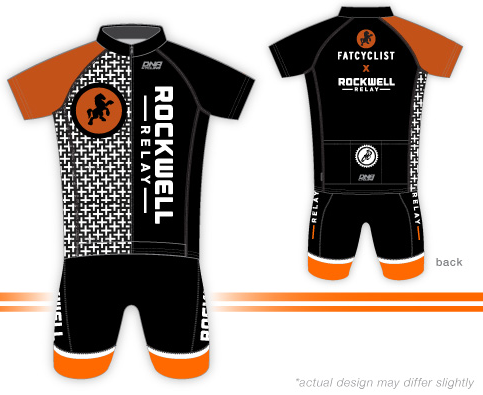
What Is The Rockwell Relay?
For those of you who don’t know what the Rockwell Relay is, allow me to encourage you to go read my race report (yes, all eleven installments). Or watch this beautiful video (see how many Team Fatty sitings you can identify) to see the kind of incredible terrain you’ll see.
But here’s the short version.
The Rockwell Relay is a 520-mile road bike relay race along the backroads from Moab, Utah to Saint George, Utah. Each team is made of four people, each of which takes turns racing specific segments of the course. Segment lengths vary, but are generally 40-50 miles long. The rider order stays the same throughout the race, and you take turns being the racer, the driver (unless you’ve got a dedicated driver), and the support crew (unless you’ve got a dedicated crew).
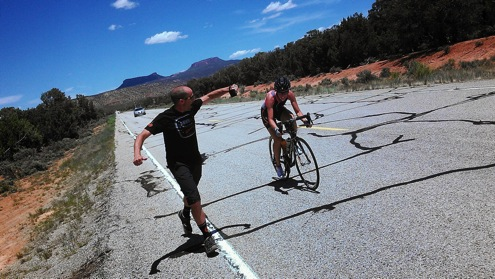
It’s intense. It’s fun. It’s brutally hard. It’s exciting.
It’s beautiful.

It is — completely honestly and truly — my very favorite cycling event.
So, clear your calendar for the weekend of June 13 – 14. I’ll grill you a bratwurst.
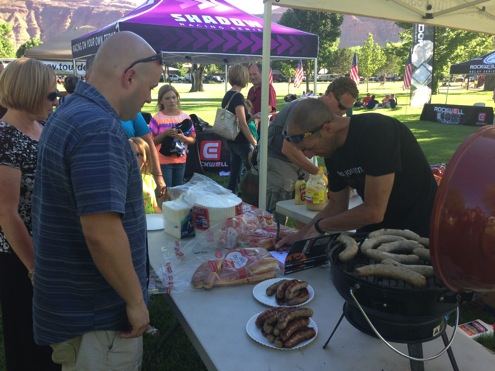
We’ll hang out, and then we’ll race.
It will be a weekend you never ever forget.
Sign Up Now
Because I love this event so much, I’ll be talking about it more in the next little while. And I’ll be encouraging you to sign up. Because I’d love to see as many Friends of Fatty do this race as possible.
And because I love this race so much, I’ve partnered up with the Rockwell Relay guys. If you sign a team up by the end of this month (February), the captain of your team will get a very nice Rockwell Relay / Fat Cyclist jersey, made by DNA Cycling. And these guys make very nice jerseys. Nice enough that the other three people on your team will want to get one too — and at only $60 / jersey, that’s about the best deal you’ll ever get on a DNA jersey.
So, sign up here. Now.
Oh, One More Thing
For the past three years in a row, Team Fatty — Kenny, Heather, The Hammer, and me — have won the coed division. We intend to win it again.
That said, our cumulative age this year will be 189 (that’s an average age of 47.25, and our youngest rider will be 45). And while a coed team can be three men and one woman, we always have — and always will — race in the true spirit of co-ededness: two women and two men. And we always have been — and always will be — a self-supported team.
So if you’re going to come after us, you may want to take those things into account as you build your team. You know, so you don’t blow us out of the water too badly.
See you in June!
Comments (28)
02.6.2014 | 10:36 am
 The Armstrong Lie
The Armstrong Lie is a documentary about Lance Armstrong. Unfortunately, Alex Gibney—the producer and/or director (I don’t know the difference and can’t be bothered to look it up) gave away the surprise revelation of the documentary right in the title: that Lance Armstrong lied. And probably continues to lie.
is a documentary about Lance Armstrong. Unfortunately, Alex Gibney—the producer and/or director (I don’t know the difference and can’t be bothered to look it up) gave away the surprise revelation of the documentary right in the title: that Lance Armstrong lied. And probably continues to lie.
So the big question is, if you start making a documentary lionizing a guy and he turns out to have been lying to you (along with pretty much everyone else) and you try to salvage the documentary by flipping its thesis on its ear and adding a couple of interviews with the guy who was — and possibly is still –lying to you (along with, as I mentioned, pretty much everyone else) in the first place, do you have a compelling story to tell?
That is the question I’ll try to answer in this review.
But first—before we even begin talking about the documentary itself–there are some mysteries that need solving.
A Big Stack and a Big Rack
The Armstrong Lie comes out on DVD on February 11, but you can buy it and stream it on Amazon.com right now. Which is what I did.
comes out on DVD on February 11, but you can buy it and stream it on Amazon.com right now. Which is what I did.
And there were a couple of very strange things about the order page.
First of all, if you buy the DVD version, you apparently get a lot of DVDs:
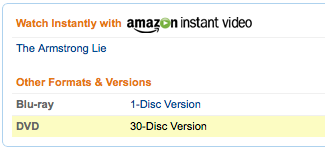
Thirty discs? What could be on thirty discs? Every single foot of footage? The most-recent backup of Gibney’s hard drive? 29 additional copies of the movie for you to give to your friends? Promotional AOL membership discs from 1993?
Or — and it is my fervent hope that this is the case — perhaps discs 2-30 contain sixty hours of hilarious outtakes and bloopers. Because that would make for both a lot of entertaining viewing and a large enough coaster set for a pretty good-sized party.
Next comes the description of the video, which shows that someone wasn’t even trying when they were filling out this particular part of the form:

“Chronicles Armstrong’s attempt to win the 2009 Tour de France?” Really? That’s the description of this 2+hour movie you’re going with?
Spoiler alert: he doesn’t win, and that’s not really what this documentary is about.
Even weirder than that, though, is the cover of the DVD case. Sure, there’s the big image, where it looks like Lance is looking (in shock and dismay) at the text that shows that this video attended the Venice and Toronto film festivals.
But then there’s the shot of Lance on his bike:
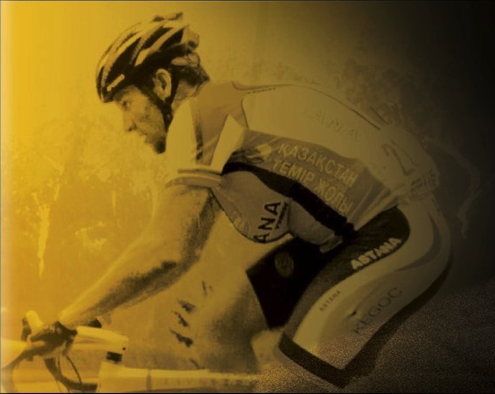
I swear on my life that I did not Photoshop this. This is the actual shot on the actual DVD case image on Amazon. And it looks like Lance has a medium-sized gut and the largest man-boobs ever seen on a professional cyclist.
To wit, it looks like someone Photoshopped Armstrong’s head onto my body.
Justify Yourself
OK, now on with the review. Kind of.
When I told The Hammer we were going to watch this documentary so I could review it for my site, she—initially—seemed fine with the idea.
But then the documentary started, beginning with Armstrong talking, just moments after his Oprah interview. And The Hammer said, “I’m not that interested in watching him tell more lies. Is that all this is going to be?”
At which point I paused the movie and told her the premise of this documentary. That, basically, Gibney originally set out to make a documentary about Armstrong’s comeback in 2009. Then, when Armstrong’s falseness was revealed, Gibney instead combined his original footage with new interviews with Armstrong and people who had a part in his undoing: Betsy and Frankie Andreu, Coyle, Walsh, Hincapie, and others.
“Do we learn anything new in this documentary?” The Hammer asked.
I told her that I didn’t know for sure, but from what I had read, didn’t think so. What we’d do, I thought, was get a better sense of the people involved.
And so The Hammer sat down with me, watching, skeptically, while I watched and typed notes.
Then, after a while, she started playing Candy Crush on her phone, so she wouldn’t fall asleep.
Then, with about 45 minutes left in the documentary, she left to go do something else.
Because, when it comes down to it, this documentary doesn’t reveal much in the “whodunnit” sense (we already know all that), nor in the “why’d he do it?” sense (Tyler explained that part much, much better). The fact is, if there’s a single defining characteristic of Lance Armstrong, it’s self-discipline. He’s going to stay on-message; the only difference is that the message has changed, somewhat. We’re not going to get a Perry Mason moment from Lance.
And most everyone in the documentary is about the same. They have a point to drive home (Lance is a doper and a bully), and they’re going to drive that point home, come hell or high water. If you come looking for the pathos behind it—which is what I was looking for–you’ll need to look elsewhere.
The exception to this is Betsy Andreu: she comes across as both forceful and forthright. Her motivation feels real and complex: anger at betrayal, a desire to protect her husband, indignation at unfairness. And her time on the screen — more than anyone else’s — feels straightforward and unfiltered.
Salvage Attempt
The backstory to this documentary is pretty interesting: Gibney started a documentary intended to showcase Armstrong’s return to racing — then resurrected it as a movie about Lance’s career in deception.
The problem with the movie is that Gibney tries to have the movie do too many things. He seems to have been too much in love with all the race footage he captured during the 2009 Tour de France, and recaps almost the entirety of the race. Very little of which has much — if anything — to do with his new subject matter (doping and deception). As a result, a documentary that should have been about eighty minutes long — tops — comes in at 124 minutes.
Gibney tries to tie the huge amount of 2009 TdF race footage to a question: was Armstrong racing clean — as he insists he was — during this tour?
Here’s the problem with this question: the documentary doesn’t really give me much of a reason to care about the answer. You’ve got a guy who’s doped for his entire career and — until recently — gotten away with it. Now he says he raced clean when he came back in 2009. Why believe him?
And more importantly, why care? Either he was doping and got beat by another doper (the presumption I’m going with), or he wasn’t doping and got beat by a doper, which happens all the time and is in no way remarkable. Either way, this documentary doesn’t give me a compelling reason to care.
Summing up, The Armstrong Lie suffers from a similar problem Armstrong correctly observed about his interview with Oprah: for people who know about Lance already, it’s too little insight. For those who don’t, it’s too much detail. And for everyone, it’s too long.
And in truth, If I didn’t have an ulterior motive — writing this review — I wouldn’t have finished The Armstrong Lie.
Though I reserve the right to revise this opinion after watching all 30 of the DVDs that should be arriving at my home soon.
Comments (37)
02.4.2014 | 12:35 pm
Greetings from the future. I send you this message back through time (WordPress started having the feature of being able to post backward in time beginning in build 5.2.1c) as guidance, and as a warning.
The Zombie Apocalypse is coming. You have seven months to prepare. Yeah, I know. Some of you are saying, “Hey, seven months isn’t exactly a lot of time to prepare. As long as you’re sending blog posts into the past, why didn’t you send it back ten years? Or at least five?”
To that, I respond: I wasn’t even blogging ten years ago, so that’s stupid. And if I had sent this post back five years, you would have had plenty of time to rationalize why it was just a silly joke—a fabrication—and you would have let your preparations lapse.
Most of you will do that anyway. (I say this both as a person with knowledge of what you consider the future, and as a person who understands the personality profile of my blog readership.)
But for those few of you who choose to take this seriously, I have some life-saving tips.
Ride
First and foremost, start riding your bike more. Ride every day. Ride as if your life depended on it.
Because it does.
See, as it turns out, cars won’t do you a lot of good once the Zombie Apocalypse begins. Sure, they’ll be great for getting away while you’ve got gas in your tank. But before long you’re going to run out. And the lines at gas stations are going to be long. Which, by the way, the zombies figure out pretty quickly. (Also, they figure out how to break windows.)
And then the gas supply dries up. And the roads get clotted with cars, making it pretty much impossible to get anywhere in a car.
But a road jammed with cars still has plenty of room for bikes to get around (ask any big-city cyclist; they’ll tell you. Endlessly.).
So start getting in shape. Get used to riding. Toughen up your butt. And—this is very important—don’t forget to do intervals. It’s impossible to overstress the value of the ability to accelerate and hold a sprint for about 200 yards. This will distance you from all but the fastest zombies (the exception being Usain Bolt [yes, he’s now a zombie], but if he chases you, you at least have the consolation of knowing you were captured, killed, and eaten by an Olympic superstar). By the time you’re that far away, the Zombie will have forgotten you (Zombies have notoriously short attention spans, and nobody has really taken it upon themselves to find out if Ritalin helps).
Also, you should work on skills drills. Practice hard stops and sharp turns. Yes, partially to give you the know-how to avoid zombies that surprise you by jumping out from behind large objects (cars, mostly). But also because in the future, auto drivers (the smug bastards who hoarded gasoline) totally ignore the three-foot foot rule.
Keep Your Bikes In Good Repair
If you are a professional bike mechanic, you are in a peculiar position: you are set to become either the most powerful people in your general geographic location, or you are about to become captive to one of the most powerful people in your geographic location.
My recommendation: learn kung-fu.
For the rest of you, now is a good time—a really, really good time to learn how to maintain a bike. And it’s a not half-bad time to consider getting a singlespeed. Chain suck always sucks, but you’d be hard pressed to find a more sucky time to get chain suck than when you’re being pursued by a zombie.
(Word to the wise: in an emergency, a quick release skewer can be used to skewer more than a wheel. Provided you’re quick enough with that quick release.)
Supplies
As it became clear to the world that the Zombie Apocalypse was nigh, people began to hoard. Sadly, however, many people hoarded very stupid things.
Specifically, people thought that hoarding cigarettes would be a good thing to hoard, with the expectation that cigarettes would make an excellent portable, high-value fungible.
This was, as I mentioned, stupid. Really stupid.
First of all, smokers—thanks to their hacking coughs, strong odor (zombies have a heightened sense of smell), and reduced lung capacity, smokers make easy pickings for zombies. And as the number of smokers decreased—and the number of surviving smokers who suddenly decided to quit sharply increased—cigarettes were definitely a buyers’ market…and nobody wanted to buy.
You know what is in strong demand in this post-apocalyptic hellscape, however? Stan’s Tire Sealant. With broken glass (from cars, see above) pretty much everywhere, the ability of your tire to survive a puncture is pretty much synonymous with your ability to survive, period.
It’s not a bad idea to stock up on tires, while you’re at it. And lube. And flat pedals (clipless pedals are currently not in fashion, for reasons I think might are probably pretty obvious.
Oh, and buy a good helmet. Not as protection from crashes necessarily, but as a way to avoid being bitten on the head. Zombies like to go straight for the brain, and a layer of styrofoam between your noggin and the ravenous undead can be downright helpful.
Get Fit-Fat
If you’ve put on a few pounds this past winter, allow me to recommend you do everything you can to keep that weight on. Having a few extra pounds on you might be the difference between surviving for the first three weeks of the Zombie Apocalypse…and not.
Hey, why do you think I’m the one writing this blogpost of warning, while other much thinner cycling writer types aren’t? It’s because with their they all died of hunger, about twenty minutes after the last batch of kale was looted from the local Whole Foods market.
So, eat up (to a point).
[Full Disclosure: In fairness, I should point out that I have a somewhat selfish motive in recommending you gain a few pounds. Specifically, those of you who take my advice to heart a little too literally will be slower than me. Which means zombies will catch you first. Plus overweight zombies are easier for me to outsprint.]
Final Warning
Finally, one last word of advice: get a good lock and chain. Your bike is more valuable than you could ever have known.
And be of good cheer. As a cyclist, your chances of survival in this Zombie-infested nightmare are better than just about anyone else’s.
They’re not as helpful against the sentient humanoid killer robots, but that’s a matter for a different post.
Comments (56)
« Previous Page Next Entries »








